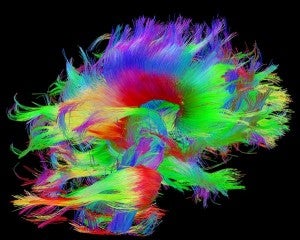November is National Alzheimer’s Disease Awareness Month
USC researchers in different disciplines try to pinpoint the start of Alzheimer’s
 Contact: Zen Vuong at (213) 300-1381 or zvuong@usc.edu
Contact: Zen Vuong at (213) 300-1381 or zvuong@usc.edu
Alzheimer’s, a disease that can bankrupt families financially and emotionally, is a wicked problem for which there is no cure even though it was discovered more than a century ago.
Family caregivers, according to the Alzheimer’s Association, spend an average of at least $5,000 a year to support a loved one with Alzheimer’s, which is the sixth leading cause of death in the United States.
With a robust community of internationally recognized faculty, USC is working to demystify the degenerative disease and find ways to prevent, treat and cure it. More than 55 researchers at USC have an expertise related to Alzheimer’s disease. Some look at the brain’s vascular system to identify Alzheimer’s before it begins. Others look at big data brain imaging and still others help families cope.
There are also the trailblazers at USC who are trying to find ground zero of Alzheimer’s to treat the disease before noticeable symptoms emerge.
_______________________________________________________
Ongoing clinical trials at USC show promise
“Thirty years ago, there were no treatments for Alzheimer’s disease. There was no acceptance of the idea that memory could be treated because memory seems a vague notion. It’s not like blood pressure, which could be measured and evaluated with precision. Memory is much more subjective. We’ve come a long way since then. We have developed the tools to study drugs for Alzheimer’s and have developed effective therapies.
“But the sad truth is that one-third of people over 65 have evidence of brain pathology called amyloid that leads to Alzheimer’s disease. Today Alzheimer’s disease is not considered to be a disorder that begins with the onset of dementia. It’s a disease that begins 15 or 20 years earlier.
“We have to initiate treatment to control the accumulation of amyloid in the brain before Alzheimer’s symptoms appear. That requires a full change in paradigm for Alzheimer’s trials where we don’t select individuals on the basis of memory impairment. We screen older, clinically normal individuals for the presence of brain amyloid. That’s exactly what we’re doing in our clinical trials at ATRI.”
Paul Aisen is director of the Alzheimer’s Therapeutic Research Institute (ATRI) and a professor of neurology at the Keck School of Medicine of USC. Aisen has been a leading figure in Alzheimer’s disease research for more than two decades; he has developed novel methodologies and designed and directed many large therapeutic trials.
Contact: (858) 964-1411 or paisen@usc.edu
_______________________________________________________
USC investigates ground zero of Alzheimer’s
“The first place in the brain that Alzheimer’s pathology is seen is in a small brainstem nucleus called the ‘locus coeruleus.’ By age 30, nearly everyone has some initial signs of this pathology in the locus coeruleus. In our research, we are examining how the locus coeruleus contributes to emotion and cognition and how it is affected in aging and Alzheimer’s disease.”
Mara Mather is a professor of gerontology at the USC Leonard Davis School of Gerontology. She is the lead scientist at the USC Emotion and Cognition Lab, where she examines how emotion strengthens high-priority memory but weakens low-priority memory.
Contact: (213) 821-1868 or mara.mather@usc.edu
_______________________________________________________
Twin studies identify risks for Alzheimer’s
“We do not yet know how to prevent or cure Alzheimer’s disease. The two main risk factors are old age and genetics. Our group is studying twins to identify risk factors that, once modified, may slow or delay the degenerative disease.
“Because twins share the same genetic risk, we can more directly study contributing factors to Alzheimer’s based on variations within the pair. Using this design, we have identified midlife diabetes, overweight and stress as modifiable risk factors. Higher education and a more complex occupation protect against Alzheimer’s.”
Margaret Gatz is a professor of psychology at the USC Dornsife College of Letters, Arts and Science. She is also a foreign adjunct professor at Karolinska Institutet, where she studies members of the Swedish Twin Registry to disentangle the role of genetic and environmental risk factors on Alzheimer’s disease.
Contact: (213) 740‑2212 or gatz@usc.edu
# # #
USC and Alzheimer’s disease research: USC researchers in multiple disciplines are seeking to untangle intractable diseases and conditions attached to aging, including Alzheimer’s and dementia. One in three seniors dies with Alzheimer’s or another dementia. Alzheimer’s is the only disease among the top 10 in America that cannot be prevented, cured or slowed.
Efforts to understand Alzheimer’s and dementia and to find preventive interventions and precise treatments are much more pressing as the baby boomer generation ages. The USC Schaeffer Center for Health Policy and Economics predicts the number of U.S. patients diagnosed with Alzheimer’s will more than double to 9.1 million in the next 35 years. By then, total annual care costs will top $1.5 trillion.



